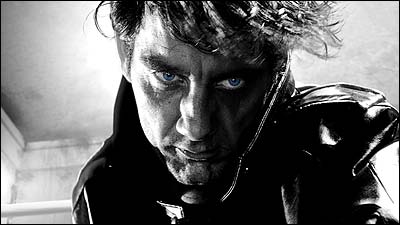
If Raymond Chandler and Daffy Duck could have produced a child, Sin City would be their baby. Hard-boiled dialogue issues from the mouths of characters who are treated like Warner Bros. cartoons—whacked at, hacked up, pummeled, yet always ready to bounce back to yap a new wisecrack. Mickey Rourke, his face and body festooned with small white Band-Aids after a fight, says of a foe, “I’m gonna give him the hard good-bye”—that is, a long, slow death. (And what a face Rourke presents here as the pill-popping Marv: Rourke’s own scarily wizened visage is actually rendered less scary yet more grotesque in heavy makeup that forces his forehead to slope into his nose with no pause for indentation; he looks like a chunk of granite abandoned by a sculptor.)
This Marv wants to avenge the death of Goldie, a prostitute he adored. In overlapping plots, an aging cop with “a bum ticker,” played by Bruce Willis, takes one last case, hunting down a pedophile, and Clive Owen’s Dwight seeks to protect an abused barmaid, Shellie (Brittany Murphy), holding a razor to the eyeball of her assailant (Benicio Del Toro) and politely introducing himself to Del Toro by whispering in his ear, “Hi, I’m Shellie’s new boyfriend, and I’m out of my mind.” The cinema-class allusions (razor-eye: Buñuel’s Un Chien Andalou; aging cop: name your Clint Eastwood movie) combine neatly with Sin City’s strikingly original look—not a knockoff of film noir, but footage that’s inky black and iridescent white, with occasional tiny, surprising splashes of color (the blue eyes of the hooker played by Gilmore Girls’ Alexis Bledel; Owen’s bloodred Converse sneakers). The movie is extensively digitalized—the actors were frequently filmed against green screens and plopped, courtesy of computer graphics, inside everything from nightclubs to cars, all added afterward. Yet Sin City throbs with a textured grunginess that was lacking in last year’s similarly techno-heavy but wanly slick Sky Captain and the World of Tomorrow. Don’t be put off by the fact that it’s the new millennium’s umpteenth comic-book adaptation: Sin City, based on writer-artist Frank Miller’s black-and-white graphic-novel series, may be fizzy entertainment straining for the dark-night-of-the-soulfulness that gave Chandler’s detective novels their resonance, but it’s also one of the most witty, and, yes, moral movies of the year.
The slashing opening credits announce that Sin City was “shot and cut” by Miller and Robert Rodriguez, with Quentin Tarantino getting a nod as “guest director” for one scene. Sin City melds both parts of Rodriguez’s sensibility—his fondness for over-the-top gore (Once Upon a Time in Mexico) and a childlike playfulness in matters of technology and adventure (his Spy Kids trilogy). Frank Miller’s comic-book work has been nihilistic even when it was most emotional (as in his revisionist Batman book, The Dark Knight Returns), but Rodriguez displays a humanism that can burst past the genre boundaries of the thriller and the multistar blockbuster (the movie wedges in Elijah Wood, Powers Boothe, Jessica Alba, Carla Gugino, Michael Madsen, and Michael Clarke Duncan).
Thus there’s real conviction behind numerous characters’ variations on the sentiment Marv mutters—“It really gets my goat when guys mess up girls.” There’s the saucy fun of making the gang of dancer/hooker/S&M girls into a band of gun-and-bow-and-arrow-toting superbad chicks, led by Rosario Dawson with a triumphant grin. There is also the relatively discreet way the kidnapped-child subplot is handled. I detest using the expressions of terrified children onscreen for any purpose, but in Sin City, that fright is spare and fraught with the full, awful implications of what it means to threaten innocence. The violence is modulated according to the scene: Yes, when the scenes pit tough guy against tough guy, there’s lots of bloodlust (limbs lopped, sharp objects inserted into skulls), but when it comes to the perv played by Nick Stahl, the movie earns its name: This city will be cleansed of the sin of hurting any victim rendered helpless.
Lest I make it sound as though Sin City is virtuousness merely tricked out in kink, let me assure you that when Owen requests a car—“a hardtop with a decent engine, and make sure it’s got a big trunk” —he’s not thinking about hiding smiley-face birthday balloons in the back. Any movie that can claim “Yeesh!” as a catchphrase—used to encapsulate unspeakable, appalled comic disgust—is up to some very naughty things. But it’s also a satisfying puzzle whose pieces fit together neatly in the end. Rodriguez has taken Miller’s often aimlessly anarchic material and given it shape, propulsion, a purpose: to suggest that sin is real, that certain existential struggles really can be reduced to (literal) black and white, that loners can band together to defeat evil. And that you shouldn’t feel guilty at experiencing a shivery thrill when Bruce Willis shoots off a guy’s ear, because the filmmakers have thoroughly convinced you that meting out such a punishment was really the only way to go.
Sin City
Directed by Robert Rodriguez and Frank Miller.
Dimension Films. R.